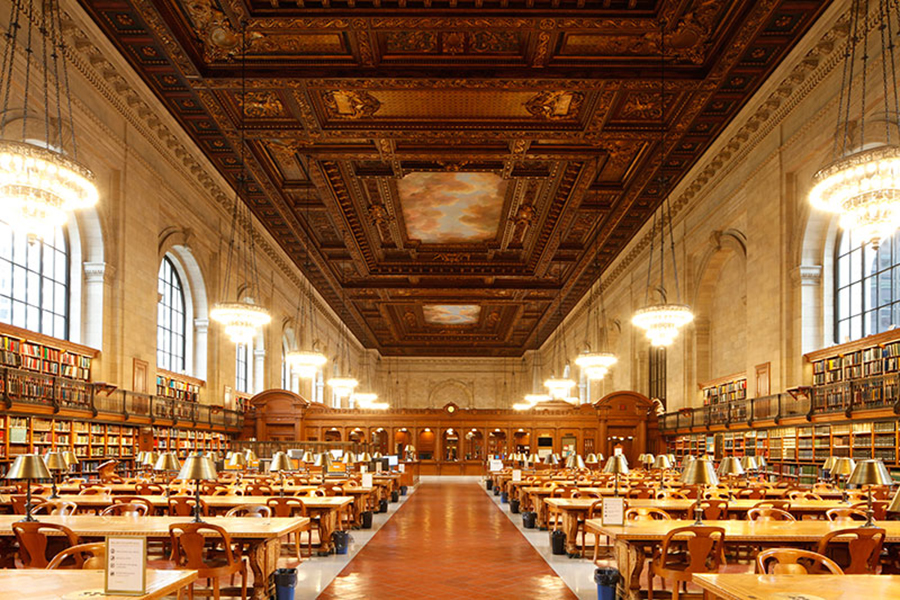|
Fall 2017 |
Inside This Issue
|
|
|
|
|
 |
| Greetings from the Chair |
This summer, the Commission completed designation of the Rose Reading Room and the Bill Blass Public Catalog room, the premier public spaces of the Main Branch of the New York Public Library (NYPL) in Manhattan. While all designated landmarks are special, interior landmarks are rare (there are only 120 in New York City, compared to 1398 Individual Landmarks) and these are among the most majestic public interior spaces in the city. Just this year, we have designated three interior landmarks - the Late and Post-Modern United Nations Hotel First Floor Interiors and the beloved interior spaces of the Waldorf Astoria Hotel, in addition to the spaces in the New York Public Library. We also recently designated the second-oldest Church in New York City - the Old St. James Episcopal Church in Elmhurst, Queens. Built in 1735 in what was then Newtown Village, the church is a significant reminder of the early colonial history in Queens. In addition to these designations, I am delighted that the Commission took the first step in considering the designation of 827-831 Broadway for their association with an extraordinary succession of prominent Abstract Expressionists, including Willem and Elaine de Kooning. The Commission also continued to receive and meet the demands of the record numbers of applications for proposed work on our already designated landmarks. We look forward to going into the fall with a renewed sense of purpose as we continue to designate and preserve New York City's most precious buildings and sites.
Sincerely,
Meenakshi Srinivasan
|
|
|
|
|
| Old St. James Designated as NYC Landmark |
The New York City Landmarks Preservation Commission unanimously voted to designate the Old St. James Episcopal Church at 86-02 Broadway in Elmhurst, Queens as a New York City Individual Landmark. The Church was built in 1735-36 in what was called Newtown Village, and is historically significant as New York City's second-oldest religious building, and oldest remaining Church of England mission church within the five boroughs. Retaining both 18th and 19th century historic design, workmanship, and materials, it is an architecturally significant example of the Colonial Meetinghouse form, combined with 19th century Gothic Revival and Stick style decorative details. Find out more
|
|
|
|
|
 |
| Rose Reading Room Newest Interior Landmark |
On August 8, 2017, the Commission unanimously voted to designate interior spaces of the New York Public Library, Stephen A. Schwarzman Building at 476 Fifth Avenue in Manhattan. Designated spaces include the Rose Main Reading Room and the Bill Blass Public Catalog Room on the third floor. These interior spaces are New York City's 120th Interior Landmark.
Both the Rose Main Reading Room and the Bill Blass Catalog Room have 52-foot tall ceilings and large arched windows that fill the rooms with natural light. The Catalog Room is 81 feet long and 77 feet wide, and the nearly two-block long and the Main Reading Room is 297 feet long and 78 feet wide. Both rooms feature a rich palette of materials, including Caen-stone walls, marble floors, elegant woodwork and bronze finishes, and important fixed furnishings, including Renaissance-style tables and bronze chandeliers. Of particular note are the molded plaster ceilings, which frame colorful murals of illuminated clouds, originally painted by James Wall Fine, and which were recently restored.
The Landmarks Preservation Commission designated the Central Building of the New York Public Library (now the Stephen A. Schwarzman Building) in 1967, and its primary circulation spaces, including Astor Hall, the Central stairs and McGraw Rotunda were New York City's first interior landmark in 1974. Learn more |
|
|
|
|
| Commission Calendars Willem de Kooning's Former Home and Studio (827-831 Broadway) |
The New York City Landmarks Preservation Commission recently voted to calendar 827-831 Broadway for a future public hearing- the first step in the designation process. The 827-31 Broadway Buildings are twin Civil War-era "commercial palaces" designed by Griffith Thomas and built for tobacco heir Pierre Lorillard in 1866-67. 831 Broadway is culturally significant for its association with an extraordinary succession of prominent Abstract Expressionists, who lived and worked there during periods of great productivity and influence in their careers, including Willem de Kooning, Elaine de Kooning, Paul Jenkins, Larry Poons, and Jules Olitski, and the curator William S. Rubin. With its twin at 827 Broadway, the ensemble represents the pivotal era in which New York City became the epicenter of the art world after World War II. Read more |
|
|
|
|
| Guide to Researching Historic Buildings |
Did you know that the Landmarks Preservation Commission has created a Guide to Researching Historic Buildings in New York City? This guide is intended to assist you as you research your building of interest by helping you find construction dates, architects, original owners, alterations, changes in ownership over time, the names of building residents, historic photos and other information. Do you want to uncover the past of a historic property? This guide can help.
|
|
|
|
|